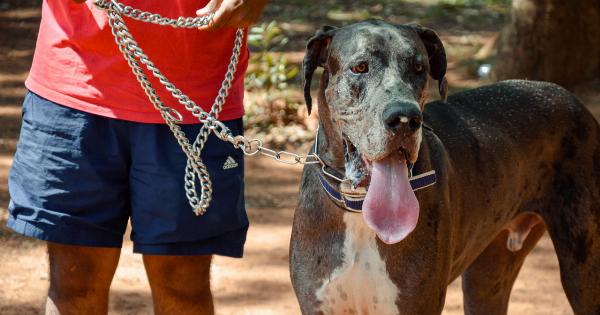Having a dog is a joyful experience, but it also comes with important responsibilities. One of the most crucial aspects of dog ownership is ensuring the safety of your furry friend, especially when taking them for walks outside.
Unfortunately, dogs can sometimes get out of their leash, which can be a moment of panic for any pet owner. However, in these situations, it is essential to stay calm and take the necessary steps to ensure your dog’s safety.
To assist you in handling such situations effectively, we have compiled a list of common errors to avoid if your dog gets out of his leash.
1. Don’t Chase Your Dog
When your dog manages to free itself from its leash, it may instinctively start running away. It can be tempting to chase after them in a state of panic, but this can often make the situation worse.
By chasing your dog, you risk scaring them further or encouraging them to run even faster. Instead, try to remain calm and use a calm tone of voice to call your dog back to you.
2. Stay Calm and Composed
It is natural to feel anxious or upset when your dog escapes, but it is crucial to remain as calm and composed as possible.
Dogs can sense their owner’s emotions, and if they pick up on your panic, they may become more frightened or stressed themselves. Take deep breaths, speak in a soothing voice, and focus on finding a solution to safely retrieve your dog.
3. Use Treats and Commands
If your dog responds well to commands, use this to your advantage. Carry treats with you during walks and use them to get your dog’s attention.
Call their name and ask them to “sit” or “stay.” If your dog comes running back to you upon hearing these commands, reward them with treats and praise. By associating obedience with positive reinforcement, your dog will be more likely to come back to you in future instances of escaping their leash.
4. Enlist Help from Others
If you are unable to retrieve your dog on your own, don’t hesitate to ask for help. Look around for fellow dog owners, neighbors, or passersby who may be willing to assist you in catching your dog.
The more people you have helping, the higher the chances of successfully bringing your dog back to safety. Additionally, having extra pairs of eyes can help locate your dog more quickly, especially if they are hiding or running around in a nearby area.
5. Don’t Yell or Punish Your Dog
When you finally manage to retrieve your dog, it is essential not to yell or punish them for escaping.
While it can be frustrating and worrisome, scolding or punishing your dog will only create fear and anxiety, potentially leading to more problematic behavior in the future. Instead, focus on rewarding their return and ensuring that they understand that coming back to you is a positive experience.
6. Secure Your Leash Properly
Prevention is always better than cure. Before going for walks, ensure that your dog’s leash is securely attached and properly fitted. A loose or incorrectly fastened leash greatly increases the chance of your dog slipping out.
Take the time to adjust the leash’s length and confirm that the clip or harness is in good working condition. This simple step can prevent the stress and potential danger that comes with a dog escaping from its leash.
7. Consider Using a Harness
Sometimes, dogs can slip out of a traditional collar and leash setup more easily. In such cases, it might be worth considering using a harness instead.
A harness wraps around your dog’s chest and shoulders, distributing the pressure evenly, which reduces the likelihood of your dog being able to wiggle free. Research different types of harnesses and consult with a professional to find the most suitable option for your dog’s size and behavior.
8. Train Your Dog Recall
A well-trained recall command can be a lifesaver if your dog manages to escape their leash. Teaching your dog to come back to you reliably when called is an essential skill that all dogs should learn.
Use positive reinforcement techniques, consistency, and patience to train your dog to respond to a recall command, such as “come” or their name. This training can improve your chances of quickly regaining control over your dog if they slip out of their leash.
9. Be Mindful of Your Surroundings
Dogs are naturally curious creatures and can easily get distracted by their environment. When walking your dog, be mindful of your surroundings and potential triggers that might tempt them to bolt.
Avoid walking close to busy roads, crowded areas, or places where your dog may encounter aggressive or overly excited dogs. By being aware of your surroundings, you can reduce the likelihood of your dog escaping their leash and getting into potentially dangerous situations.
10. Consider Microchipping Your Dog
Even with the utmost precautions, there is always a small chance that your dog may escape their leash. In case your dog does manage to run away, having a microchip can significantly increase the likelihood of being reunited with your furry friend.
Microchipping involves implanting a tiny chip under your dog’s skin, which contains contact information that can be scanned by animal shelters or veterinary clinics. Registering the microchip and keeping your contact details up to date ensures that if your dog is found, you can be easily contacted.
Conclusion
While it can be a distressing experience if your dog manages to escape their leash, it is important to stay calm and act quickly. Avoid chasing them, enlist help from others, and use treats and commands to call them back.
Secure your leash properly, consider using a harness, and train your dog recall to prevent future escapes. Be mindful of your surroundings, and in case of emergency, having your dog microchipped can greatly increase the chances of a safe reunion.
By following these strategies and avoiding common errors, you can ensure your furry friend remains safe during walks and adventures together.



























